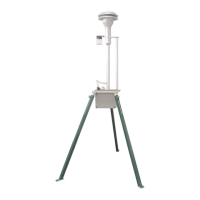On July 18, 1997, U.S. EPA changed the regulations for the operation of mass flow controlled
instruments (e.g., the PQ100). Previously, EPA specified a set of AEPA Standard Conditions@,
which were 25 degrees C and 760 mm of Hg.
Now, mass flow controlled instruments are to be run in Avolumetric mode@. The details of
EPA=s recommended calibration procedure may be found in general form 40 CFR Part 50,
Appendix M, 8.2.4 July 18, 1997. When applying these instructions to the PQ100, the following
steps are suggested:
1. Place a clean filter of the type to be used for the sampling in the PQ100 filter
holder.
2. Remove the PM10 inlet and connect a bubble meter to the filter holder. BGI
adaptor (P/N L-30) is convenient for this purpose.
3. Enter the calibration mode and adjust the flow up or down until the flow meter
reads 16.67 LPM and lock the flow rate.
4. Record the barometric pressure and temperature at the time of calibration.
5. This procedure provides volumetric flow rate control as long as there are no shifts
in temperature. EPA recommends the use of seasonal average values. In the case
of the PQ100, this requires calibration for each season of intended use. Since it is
not practical to be out of doors to perform the calibration, a facility has been
provided in the calculation section of our software supplied with the PQ100.
6. In software, selection the correction calculator. Then select (C) AEPA volumetric
or user defined conditions@.
For T insert average seasonal local temperature
For P insert average seasonal local barometric pressure
For sample target flow rate enter 16.67 lpm
Enter Pstd at calibration location (local)
Enter Tstd at calibration location (local)
The program will return the flow rate which is to be observed on the flow meter in
order to be running in the field at 16.67 lpm.
EPA regulations require that you calibrate at 3 flow rates. The other two flow rates
selected are generally in the range of 15 lpm and 18.4 lpm (∀ 10%). This procedure
serves no particular purpose with the PQ100 which is microprocessor controlled.
However, it is a statutory requirement and must be performed for concentration
measurements to be compliant. An example of the calibration procedure is illustrative:

